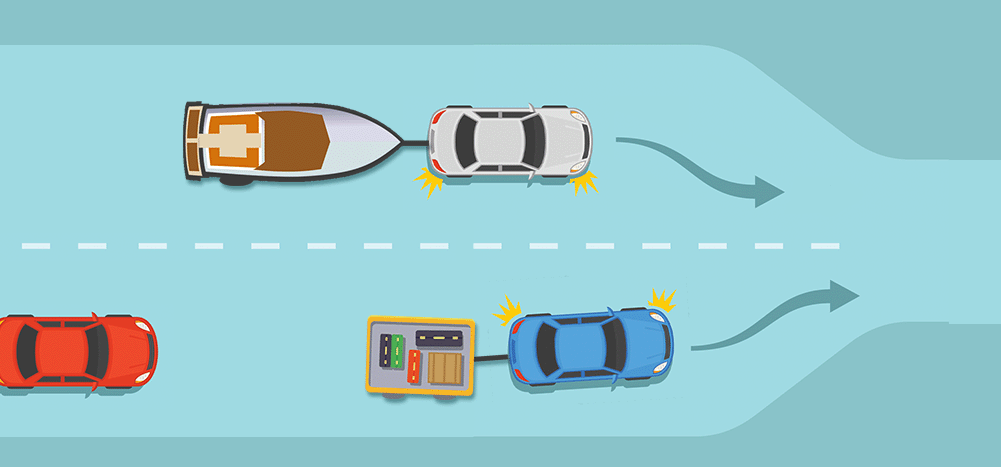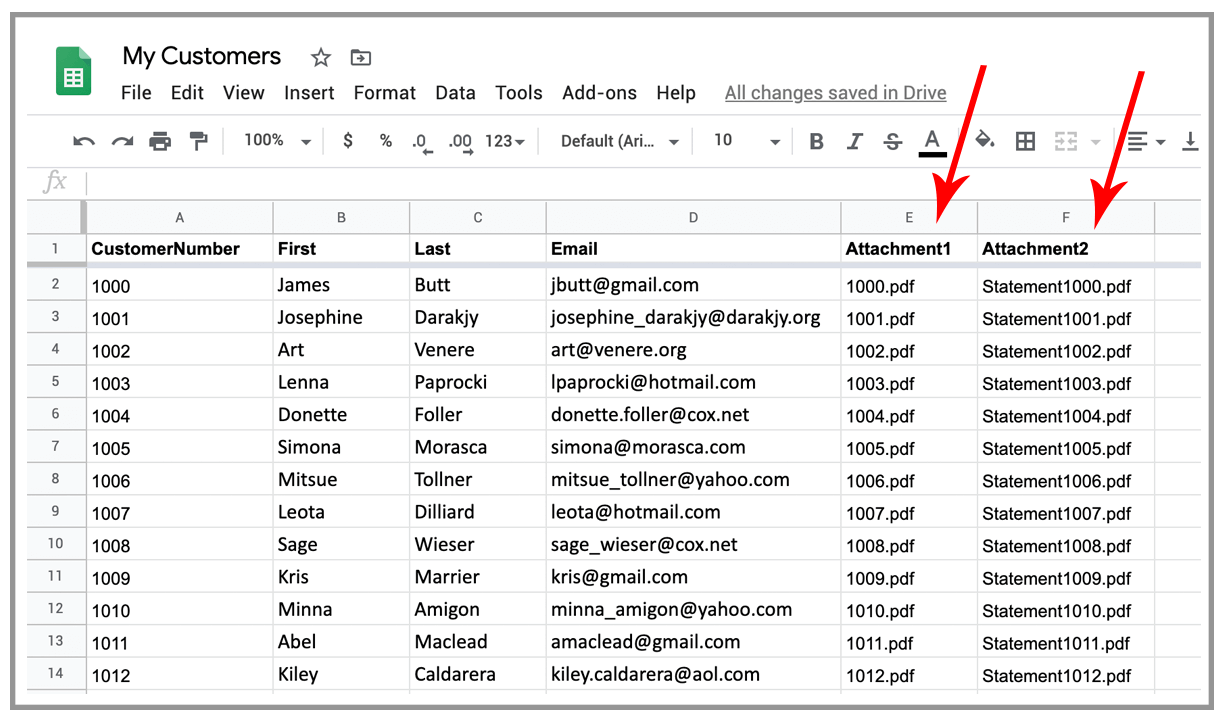
Many people use the Microsoft Word mail merge to send bulk emails. However, it only supports basic mail merge features. Microsoft Word cannot attach individual files in mail merges.
If you want to add individual attachments (such as an invoice or any other mail merge PDF) or personalize your subject lines, add CC or BCC, you’ll need third-party MS Word Mail Merge add-ins that work with significant restrictions. There are a lot of steps involved, and you must pay for the most expensive license to do certain things. GMass is a Chrome extension that handles these Microsoft Word mail merge limitations and allows you to send mail merges with attachments in Gmail quickly. In this article, we’ll show you how to mail merge with attachments in MS Outlook and Gmail and compare the two.
This article includes:
How to do a Mail Merge with Attachments
Mail Merge with Attachments in Microsoft Outlook
- Limitations of Microsoft Outlook Mail Merge Method
- MS Word Mail Merge with Attachments (Step-by-Step Method)
Mail Merge with Attachments in Gmail
- Use Case 1: Mail merge with individual/personalized attachments.
- Use Case 2: Mail merge with the same file as an attachment to all e-mails.
How to do a Mail Merge with Attachments
You can use third-party add-ins or scripts with Microsoft Word to create a mail merge with attachments, or you may use GMass with Gmail. We’ll look at how each method works and discuss its advantages and disadvantages:
Method 1: Mail Merge with Attachments in Microsoft Outlook
You can’t directly attach files in Microsoft Word mail merge. Instead, you’ll need third-party Add-ins like the “Outlook Mail Merge Attachment (OMMA),” “Merge Tools Add-In,” or “Mail merge toolkit.”
These add-ins are limited by the following factors:
- Sending Failures: Email servers limit the number of outgoing emails sent in a particular time frame to prevent unsolicited bulk emails. Because MS Outlook and these add-ins lack a feature that controls email sending rates, your email server may blacklist you from sending a large number of emails. Consequently, you could receive errors with delivery, and many emails might be sitting in your Outbox that you’ll need to send manually.
- Poor Deliverability: When the recipients’ servers detect a large number of bulk emails from a specific sender in a short period of time, their SPAM detection systems are triggered. The incoming servers may reject these bulk emails or put them in the SPAM/promotions tab. There are no add-ins that provide the functionality to send mass emails in batches or with a delay under Standard licenses. The “Mail Merge Toolkit” has batch delivery support, but only the most expensive license provides access to it. Nonetheless, it isn’t as efficient as GMass. Since GMass sends emails straight from the Gmail interface with advanced throttling, it mimics human behavior as though someone composed and sent each email manually. As a result, GMass helps to achieve better deliverability.
- The majority of these add-ons lack email tracking capabilities. These Add-ons don’t have a mechanism for tracking and reporting accurate email opens and clicks. Some add-ons provide basic email tracking features such as “read receipts” or “Google Analytics integration.” Unfortunately, many people do not always manually accept the read receipts, and some recipient mailboxes may have pixel blockers enabled; determining how many people open your emails using these methods is difficult. Then there are false opens from bots. Google Analytics also doesn’t tell who opened your email (except for some demographic data). GMass provides accurate click tracking data, including the email ID, time, and IP address.
- In certain situations, emails generated with Microsoft Word Mail Merge might have formatting or spacing errors. These add-ins generate and attach the PDFs in emails and send them to Outlook Outbox. As a result, the merged documents aren’t free of errors.
- Lack of personalization: If you’re using Microsoft Word Mail Merge with these add-ins, you have limited control over your email’s subject line or body. You can’t achieve GMass-level personalization.
- Some of these Add-ins don’t work on Mac or Linux systems.
Here’s how to create a mail merge with attachments in Microsoft Outlook:
Step 1: Download the Zip folder of any of these Add-ons. In this case, we will use the “Outlook Mail Merge Attachment (OMMA).”
Step 2: Extract the zip folder to your local hard drive.
Step 3: In Microsoft Outlook, click on the “Work Offline” button in the Send/Receive tab. Enabling offline mode ensures that the Mail Merge emails are kept in the Outbox and not sent immediately. Next, confirm that there are no existing messages in the Outbox.

Step 4: Create a Mail Merge document in MS Word and finish the merge as usual. Outlook will place the emails in the Outbox folder.
Step 5: Open the “Outlook Mail Merge Attachment” folder you extracted and execute (double-click) the “Outlook Mail Merge Attachment.vbs” file. If you’ve previously included attachments in your merged emails, the program will notify you of this and allow you to attach the files.

Step 6: Select the attachments. If you’d like multiple files attached to all of your outbox drafts, select them, and the script will do it for you. The script now adds the selected file to all the emails in the Outbox.
Step 7: Go Online – Disable the “Work Offline” option in Outlook and send the mail merge.
Note: You may also use another add-in, “Mail Merge Tool Kit,” to generate and attach personalized PDFs/Docs.
Method 2: Mail Merge with Attachments in Gmail
You can use GMass to send a Gmail mail merge with attachments. In addition, GMass provides features that are not available in the typical Microsoft Word Mail Merge procedure:
-
- Ability to add multiple personalized attachments: With GMass, you can easily create mail merge campaigns in Gmail and attach personalized attachments.
- Advanced Personalization: GMass allows you to personalize your mail merge campaign more effectively than a standard Word Mail Merge. With GMass, you can personalize anything, including the subject line and body of the email, and add pictures, links, and attachments.
- Improved deliverability: GMass improves your email deliverability by optimizing your campaigns. GMass also Throttles your mail merge speed to reduce the risk of the recipient email server blocking you for suspected spam.
- GMass allows you to save your merged emails as Drafts in Gmail first, review them for accuracy, and then send them with a single click.
- GMass works to deliver more accurate open and click tracking for your emails.
- You can also send attachments using the GMass API.
With GMass, you may use Gmail to send a Mail Merge with personalized messages, attachments, and other data from your spreadsheet. We’ll show you how to create a mail merge with attachments in Gmail using GMass.
To create a mail merge with attachments using Gmail and Google Sheets, follow the steps below:
Use Case 1: Mail merge with individual/personalized attachments.
Step 1: Add GMass to your Gmail or Google Workspace account.
Download the GMass Google Chrome extension and sign up for free with your Gmail or Google Workspace (previously G Suite) account.
Step 2: Host your attachments online
Host your attachment files on Google Drive, Dropbox, or any similar service such as your web server.
-
-
- If you’re using Google Drive, make sure GMass has read-only access to the attachment files. FOLLOW THIS LINK To allow GMass to download different attachment files from your Google Drive.
- You must log in with the same Gmail account that you’re using to send your mass email.
-
-
-
- Also, the files don’t all have to be in the same folder; they can be spread across multiple folders as long as they’re in one single Google Drive account.
- Finally, if you’re using Google Drive, make sure the “Convert uploaded files…” option is unchecked:
-

Step 3: Setup your Google Spreadsheet for Mail Merge.
Create a Google Spreadsheet that lists the email addresses in one column and the file names in the other.

-
-
-
- For best results, keep your column names free of spaces and special characters. For your column headers, stick with numbers and letters. The actual data should begin from the second row.
- At least one column should include email addresses, which GMass will automatically identify and utilize as the recipient address column. If your Google spreadsheet has several columns with email addresses, keep the column with the recipient addresses to the left of the other columns.
- You may simply mention the file name in the attachment column if your files are saved in Google Drive. The attachment column should contain the entire URL to the file if it is hosted on the internet.
- The attachment column’s name may be whatever you like, as long as it begins with the word “attachment.” The following are acceptable column names: Attachment, Attachment1, AttachmentFile, or attachment22.
- If you need to send multiple attachments to each recipient, add a new column to your spreadsheet for each attachment.
-
-

Step 4: Connect your spreadsheet with GMass in Gmail
Click on the Sheets connector button near the search bar in Gmail, choose your spreadsheet and worksheet, and hit the “Connect to spreadsheet” button.

Step 5: After you connect your spreadsheet, the Gmail compose will open. Compose, and send your message.

If you want an attachment to go to all recipients, attach the file directly to the Gmail compose window. In that case, any files you attach to the Draft will be sent to all recipients.
Step 6: Hit the GMass button to send your mail merge.
Use Case 2: Mail merge with the same file as an attachment to all e-mails.
If you want an attachment to go to all recipients, you don’t need to upload the files to Google drive. Simply skip step 2 and the attachment column in Step 3. Instead, attach the file directly to the Gmail compose window. In that case, any files you attach to the Draft will be sent to all recipients.
File Types You Can Attach With Gmail Mail Merge:
PDFs, Microsoft Word, Powerpoint, and Excel Files, Pictures, Audio, and video files.
Here’s a detailed guide on mail merge personalization and how to send mass emails with personalized attachments in Gmail.
Email marketing. Cold email. Mail merge. Avoid the spam folder. Easy to learn and use. All inside Gmail.
TRY GMASS FOR FREE
Download Chrome extension - 30 second install!
No credit card required
